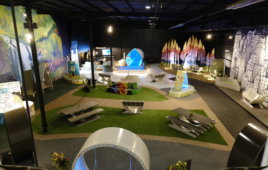The National Renewable Energy Laboratory (NREL) has selected HP and Intel to provide an energy efficient, high-performance computer (HPC) system dedicated to energy-systems integration, renewable-energy research, and energy-efficiency technologies. The $10 million HPC system will reside at the Energy Systems Integration Facility (ESIF), under construction on the Golden, Colorado, campus. The computer will expand NREL’s modeling and simulation capabilities, including advancing materials research and developing a deeper understanding of biological and chemical processes. It will also support research into fully integrated energy systems that would otherwise be too expensive, or even impossible, to study directly. The HPC’s petascale computing capability (1015 calculations per second) is the world’s largest computing capability dedicated solely to renewable energy and energy efficiency research.
The new center will provide additional computing resources to support the breadth of research at NREL, leading to increased efficiency and lower costs for research into clean energy technologies including solar photovoltaics, wind energy, electric vehicles, buildings technologies, and renewable fuels.
“This capability sets NREL apart in our ability to continue groundbreaking research and analysis,” NREL Director Dan Arvizu said. “In partnership with HP and Intel, NREL is acquiring one of the most energy efficient, high performance computer systems in the world for our research.”
The new computer for the NREL “data center” will require several floors, crunch equations at petascale speeds, and then provide heat for the facility.
The HPC data center at NREL will be the world’s most energy efficient, with an annualized average power usage effectiveness (PUE) rating of 1.06 or better. The average data center operates with a PUE of 1.91, according to 2009 data from the Environmental Protection Agency’s Energy Star Program. NREL’s data-center design is compact, resulting in short runs for electrical and plumbing components. The project features technology under development that uses warm water in the computing rack to efficiently cool the servers.
NREL will maximize the reuse of heat generated by the HPC system. The “waste heat” from the computer system will be used as the primary heat source in the ESIF offices and lab space. Excess heat can also be exported to adjacent buildings and other areas of the NREL campus. All together, the efficiency of the data center, the energy efficiency features of the HPC system and the system’s ability to reuse heat combine to reduce overall energy use. The system is projected to deliver substantial energy savings and avoid significant costs through the efficiency improvements. The project will help the Energy Department implement an Executive Order on federal sustainability that set energy efficiency goals across the federal government.
“NREL needed a system that would deliver on its commitment to energy efficiency while achieving the highest levels of performance for their researchers,” Scott Misage, director, HPC, HP, said. “HP ProLiant servers and innovative water cooled design provide the foundation needed to make this data center one of the most efficient in the world, while reaching petascale performance.”
The computer will be deployed in two phases that will include scalable HP ProLiant SL230s and SL250s Generation 8 (Gen8) servers based on eight-core Intel Xeon E5-2670 processors as well as the next generation of servers featuring future 22 nm Ivy Bridge architecture based Intel Xeon processors and Intel Many Integrated Core architecture based Intel Xeon Phi co-processors. The first phase of the HPC installation will begin in November 2012, reaching petascale capacity in the summer of 2013. HP and Intel were selected after a competitive, open procurement process.
“Research on renewable energy and new energy sources are areas aimed to address humanity’s biggest challenges and will impact literally everyone on the globe. Our collaboration with HP and NREL is also bringing computer architecture and system cooling to accelerate innovation in more efficient use of energy critical for achieving exascale performance by end of the decade,” Stephen Wheat, general manager of High Performance Computing at Intel said.
NREL
nrel.gov
Hewlett Packard
hp.com
Intel
intel.com
Windpower Engineering & Development
Filed Under: Green engineering • renewable energy • sustainability




